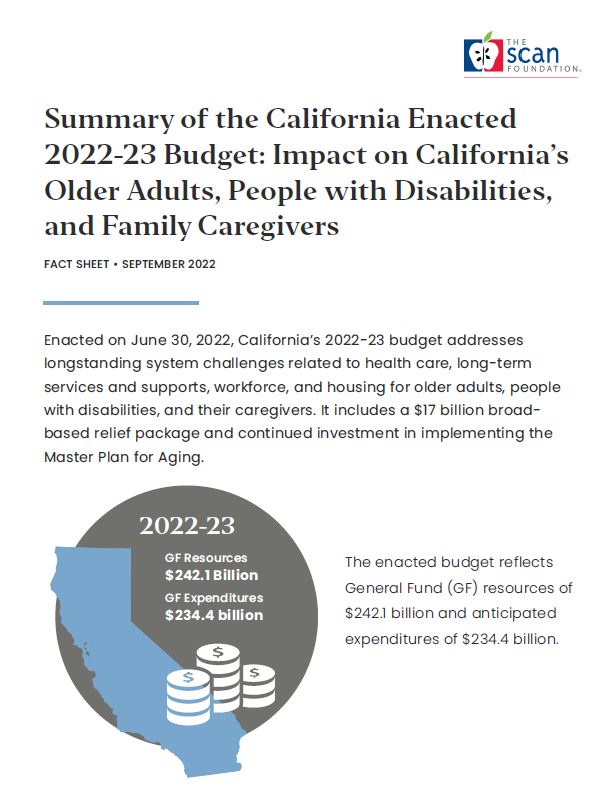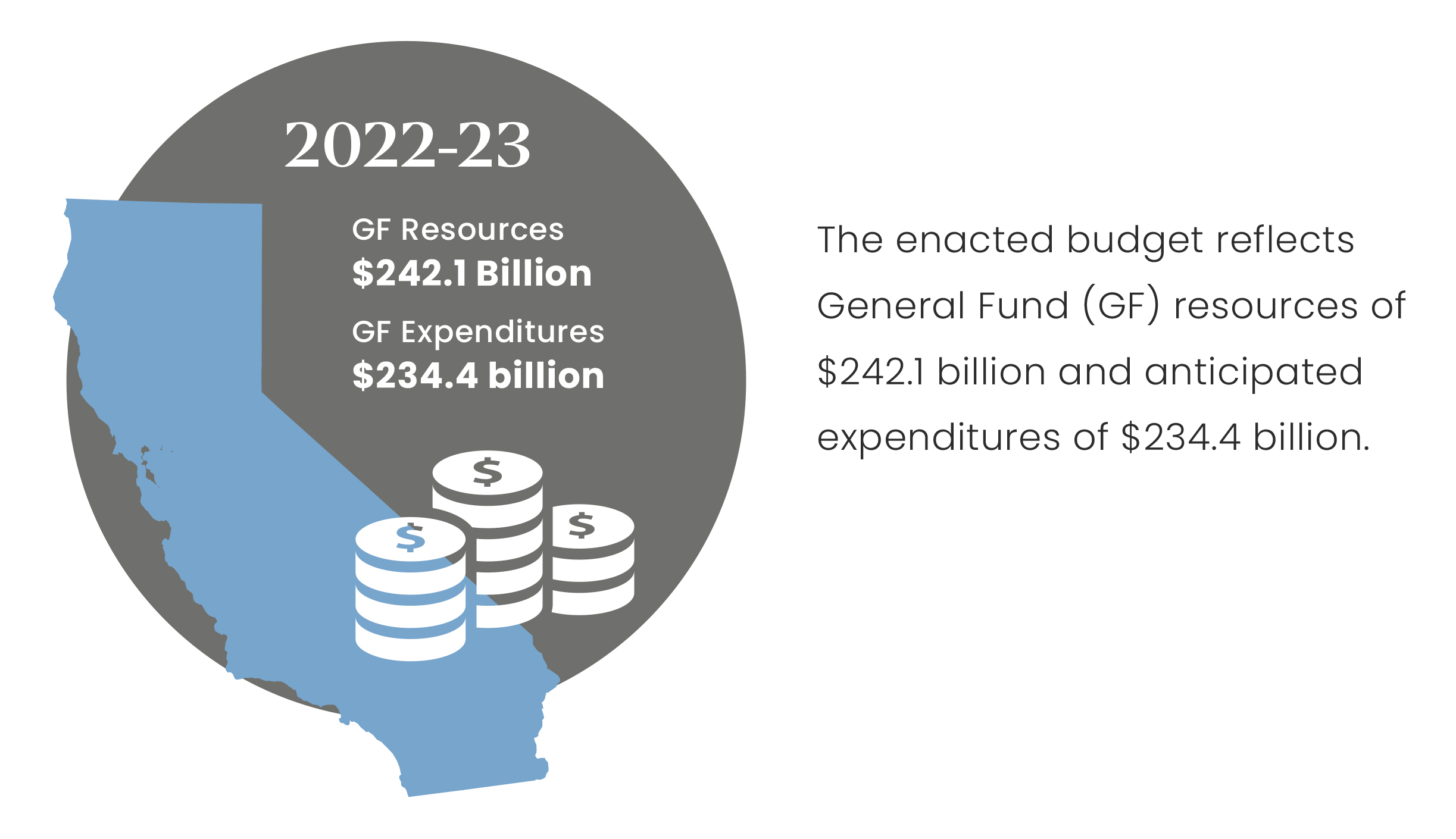Summary of the California Enacted 2022-23 Budget: Impact on California’s Older Adults, People with Disabilities, and Family Caregivers
summary
Enacted on June 30, 2022, California’s 2022-23 budget addresses longstanding system challenges related to health care, long-term services and supports, workforce, and housing for older adults, people with disabilities, and their caregivers. It includes a $17 billion broad-based relief package and continued investment in implementing the Master Plan for Aging.
Date Updated: 09/06/2022Overview
The 2022-23 budget includes investments addressing health care access, long-term services and supports, economic security, affordable housing, and workforce development that impact older adults, people with disabilities, and their caregivers. The enacted budget reflects General Fund (GF) resources of $242.1 billion and anticipated expenditures of $234.4 billion, including more than $17 billion in a broad-based relief package and $37.2 billion in reserves.1
Transforming Aging in California
Released in January 2021, California’s Master Plan for Aging (Master Plan) offers a blueprint for funding priorities over the next nine years. The enacted budget includes significant investments and emerging opportunities aligned with the goals in the Master Plan: 1) Housing for All Ages and Stages, 2) Health Reimagined, 3) Inclusion and Equity, not Isolation, 4) Caregiving that Works, and 5) Affording Aging.2
As a living document, it is meant to be continuously revisited and improved upon to reflect the current environment and needs of California’s aging population. The budget includes $36 million for ongoing Master Plan implementation, including the Data Dashboard designed to drive outcomes and sustain public engagement for statewide initiatives. Transformative investments in planning, capacity building, infrastructure development, program expansion, and data to support the Master Plan improve the state’s ability to provide person-centered, equitable care in health, housing, and social supports.1
California’s 2022-23 Budget: Impact on Older Adults, People with Disabilities, and Family Caregivers
The enacted 2022-23 budget includes a range of new investments and commitments that align with the Master Plan. Several new investments are supported through one-time American Rescue Plan Act of 2021 funding.3
Significant health care investments that expand access to Medi-Cal, implement CalAIM, and other health-related items are outlined in Table 1 below. In addition, the budget recognizes two core policy changes. First, the budget makes permanent a COVID-19 regulatory flexibility referred to as presumptive eligibility, allowing hospitals to provide Medi-Cal benefits to adults age 65 and older based on preliminary information. Second, the budget commits to reforming the Medi-Cal Share of Cost program, which raises the monthly amount people can retain for basic needs from the current set amount of $600 to an income-based calculation of 138 percent of the federal poverty level (FPL) on January 1, 2025, subject to budget appropriation.1,4
| Table 1: Health Care Affordability and Access 1,5,6 | ||
| Item | Action | 2022-23 Enacted Budget |
| Alzheimer’s Healthy Brain Initiative | Continues support of the Healthy Brain Initiative for existing grantees in six local health jurisdictions with expansion to up to six more | $10 million* |
| CalAIM Implementation | Implements managed care for dual eligibles, including:
|
$3.1 billion ($1.2 billion GF) in 2022-23 |
| Equity and Practice Transformation Provider Payments | Provides payments to Medi-Cal managed care plans or providers through June 2027 to advance equity, reduce disparities, and improve quality care | $140 million ($70 million GF) in 2022-23 |
| Medi-Cal Community-Based Mobile Crisis Services | Creates 24-hour mobile crisis intervention services as a Medi-Cal behavioral health benefit by January 1, 2023 | $1.4 billion ($335 million GF) over five years |
| Medi-Cal Asset Limit | Phases in the elimination of the Medi-Cal asset limit with full elimination no sooner than January 2024 | $93.4 million GF |
| Medi-Cal Expansion | Expands Medi-Cal to eligible adults ages 26 to 49 regardless of immigration status, providing coverage for immigrants with disabilities by January 2024 | $835.6 million ($626.1 million GF) in 2022-23 |
| Medi-Cal Premiums | Reduces Medi-Cal premiums to zero for working adults with disabilities. | $2.3 million GF |
| Skilled Nursing Faculty Financing Reform | Includes a 4 percent rate increase and establishes a Workforce and Quality Incentive Program | $340.2 million ($164.6 million GF) |
Table 2 reflects the investments to enhance long-term services and supports (LTSS).
| Table 2: Long-Term Services and Supports 1,5,6,7,8 | ||
| Item | Action | 2022-23 Enacted Budget |
| Caregiver Resource Centers (CRCs) | Transfers oversight of CRCs from the Department of Health Care Services (DHCS) to the California Department on Aging (CDA) | $15 million GF |
| Community-Based Adult Services (CBAS) COVID-19 Mitigation & Resilience | Supports CBAS providers responding to and mitigating the impact of COVID-19 with adult day services | $61.4 million GF* |
| Community Living Fund | Assists older adults and people with disabilities in transitioning from nursing homes to independent living | $10 million GF* |
| Home and Community-Based Services (HCBS) | Funds evaluation of the state’s HCBS programs beyond programs offered through Medi-Cal | $4 million (GF)* |
| In-Home Supportive Services (IHSS) | Establishes a permanent backup provider system | $34.4 million ($15.4 million GF) |
| Long-Term Care (LTC) Ombudsman | Funds a public awareness and outreach campaign for the LTC Ombudsman program | $3.5 million (GF)* |
| LTSS Feasibility Study | Expands the prior LTSS feasibility and actuarial study to assess financing and services options for the aging population and people with disabilities | $5 million GF |
| Modernizing the Older Californians Act | Supports creation of pilot programs supporting community-based services programs, family caregiver supports, Senior Volunteer Department, and aging in place | $59.3 million GF* |
The enacted budget addresses the housing crisis by allocating $2.9 billion of investments in affordable housing initiatives to accelerate the development of homeownership opportunities and $10.2 billion in services for those experiencing homelessness. Table 3 highlights key initiatives from these investments and others that could directly impact older adults and people with disabilities.1
| Table 3: Housing and Homelessness1,5,7,9 | ||
| Item | Action | 2022-23 Enacted Budget |
| Accessory Dwelling Units (ADU) Financing | Provides reimbursement grants for pre-development and nonrecurring costs associated with the construction of ADUs | $50 million GF* |
| Age-Friendly Community Grants | Provides competitive grants to local jurisdictions for planning and developing an age-friendly action plan | $4.5 million GF* |
| Community Care Expansion Program | Provides operating subsidy reserves for existing adult and senior residential care facilities | $55 million GF* |
| Healthier Homes | Establishes the Healthier Homes – Age in Place Nursing Program pilot program | $12.5 million GF |
| Homekey 2.0 | Facilitates more than 10,000 new units of housing through Homekey for Californians experiencing homelessness | $1.3 billion |
| Homeless, Housing, Assistance, and Prevention Program (HHAP) | Fund grants through HHAP for cities, counties, and continuums of care to create local plans to address the challenges of homelessness | $1 billion GF |
| Returning Home Well Program | Creates transitional housing for parolees (about 25 percent of this population is over the age of 50) | $10.6 million GF annually for three years |
| Veterans Housing and Homeless Prevention Program | Augments funding for the Veterans Housing and Homeless Prevention Bond Act of 2014 to support veterans’ housing needs | $1.5 million GF |
The enacted budget provides significant investments to address health care workforce shortages broadly. Table 4 reflects investments to support workforce development, including training, leadership development, and volunteer opportunities for older adults.1
| Table 4: Workforce and Volunteer Infrastructure 1,5,6 | ||
| Item | Action | 2022-23 Enacted Budget |
| Aging and Disability Institute of Learning and Innovation | Provides training, technical assistance, and leadership development to specified programs serving older adults and people with disabilities | $682,000 |
| Foster Grandparents and Senior Companion Program | Engages older adults in intergenerational and peer-to-peer volunteer opportunities | $10 million GF* |
| Health and Human Services Workforce | Strengthens and expands the state’s health and human services workforce, including nursing, community health workers, social work, and behavioral health | $1.05 billion GF* (over three years) |
The enacted budget invests in economic security, food access, and elder justice initiatives to assist California’s low-income older adults, people with disabilities, and others in obtaining income support and food assistance, as outlined in Table 6.1
| Table 5: Economic and Food Security, and Elder Justice 1, 5,6 | ||
| Item | Action | 2022-23 Enacted Budget |
| Adult Protective Services (APS) | Expands training opportunities for APS workers | $4.6 million GF |
| Community Assistance, Recovery, and Empowerment (CARE) Court | Supports the Department of Health Care Services and Department of Aging along with the Judicial Branch to establish and administer CARE Courts | $64.7 million GF (2022-23) $49 million GF (ongoing) |
| Energy Relief | Provides California Emergency Relief Funds to support the California Arrearage Payment Program accrued during the COVID-19 pandemic | $1.2 billion GF* |
| Food Bank Support | Supports food banks to purchase, store, and transport food produced in the state | $112 million GF* |
| Low Income Household Water Assistance Program (LIHWAP) | Funds LIHWAP to address the residential water and wastewater arrearages accrued during the COVID-19 pandemic | $200 million* |
| Supplemental Security Income (SSI)/State Supplementary Payment (SSP) Payment | Accelerates the increase to restore SSP grants to 2009 levels from January 1, 2024, to July 1, 2023. The Budget assumes an additional $296 million General Fund in 2023-24 and a $593 million ongoing General Fund for an additional increase beginning January 1, 2024. | $150 million GF (2022-23) $150 million (2022-24) |
Download the publication for all visuals and complete references.
Continue Reading
This policy brief provides an introduction to The SCAN Foundation’s CLASS Technical Assistance Brief Series, which explores many of the critical issues to be considered for successfully implementing CLASS.
This policy brief describes the broad needs of individuals with disability and the wide range of supportive and environmental solutions that can allow for the most independent living possible. It suggests how findings on social and environmental supports for individuals with disability can inform implementation of CLASS.
This policy brief provides background on the historical development of benefit eligibility triggers in the private long-term care insurance market. Understanding how these triggers came into being can provide important information to those charged with implementing the CLASS Plan.



